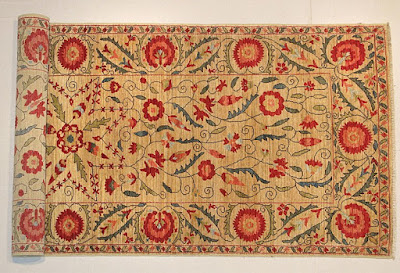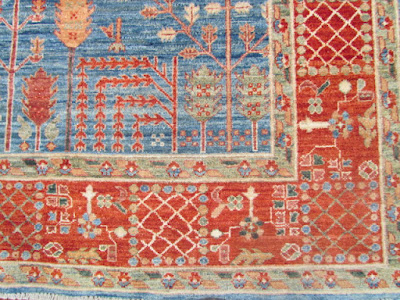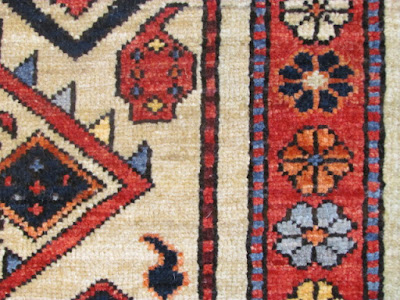 |
| An Antique Suzani |
 |
| Suzani design elements incorporated into a new rug |
Perhaps the greatest surprise as these wheels of change roll over is the unexpected quality in rugs made in Afghanistan. In recent decades the best quality hand-woven rugs have come from China and Turkey. China used the finest weave. Turkey used plant dyes instead of aniline dyes. But now there is some competition from that unruly child of Asia - Afghanistan.
The speed with which Afghanistan has emerged as a major market, the major new market, in terms of weaving traditional Persian and Caucasian designs, is astonishing. Afghanistan is perhaps best known in the rug world for the standard red and black "elephant foot" design (actually these are tribal guls). But these rugs are a dime a dozen and were mass produced with aniline dyes.
 |
| The classic "Elephant Foot" Afghan rug |
The new Afghan rugs are very striking. A lot of this is to do with the dyes. The blues are made from the indigo plant, the reds are made from pounding the madder root into a pulp. Because the dyes are the same as those used in Antique Persian rugs, these new Afghan rugs look very similar indeed to the Antiques. So it is no surprise that we have sold 29 of these rugs in the last 30 days.
 |
| Indigo Leaves |
 |
| Madder Roots |
 |
| Location of Mazar-i-Sharif |
 |
| Don't mess with this guy. He is a Hazara |
Let us look at a few examples for now..
1. The most popular design that we sell from Afghanistan is the classic tree of life and twin Cypress tree motif. Just look at the depth of blue there! This design also comes in small squares (see photo at bottom) and a range of colorways. In terms of design the parent image looks like it came from a Persian Tribal Bakhtiari.
2. These amazing Afghan rugs comes in all shape, sizes and designs. Here is an example of a large area rug in the Ottoman style of the Egyptian Mamelukes. This highly detailed and geometric design has also been making something of an appearance and is being made in a wide range of colors.
3. The Cypress is certainly a favored motif by the Afghans and originally by the Persian Tribal Bakhtiari. So too the willow tree, which is also featured in this rug. Here is an example of a mid-size piece in light blue indigo and rust madder red. The variegated striations in the blue field are the result of intentionally tye-dying. ..
4. These rugs are also available in runners..
5. And of course, many many smaller area rugs. Some are new creations, such as this vibrant rug. Tell me, have you ever seen such rich and dense natural dyed yarn? I don't think I have...
While some are efforts to replicate the specific look of a particular tribal rug, such as this light-toned Sarab from the north-western part of Iran...
While other rugs have drawn their inspiration from the tribal rugs of the Caucasus, such as this reproduction of a Kazak...































I could create a strategy for getting these rugs out by air. If in fact they are carried by ponies on that trail, there is an alternative.
ReplyDeletefascinating
ReplyDeleteMajority of the world fantacizes about the West, but i feel, infact know that the East too has a lot of richness to offer in almost all spheres. I like this post. Thankyou
ReplyDeleteGreat post about the Afghans Ride Again. By Bruce McLaren.Get the Silk carpets online
ReplyDeleteThank you, I appreciate that I getting a lot of good and reliable information from your post. Thanks for sharing such kind of nice and wonderful post.
ReplyDeleteReally cool stuff you have shared! Thank You...
Oriental Rugs Melbourne | Persian Rugs Australia
Reading about the resurgence of Afghan rug weaving really caught my attention. The craftsmanship and color depth in these new rugs rivals even some of the finest Persian pieces. I’ve been exploring carpets recently for my own home and this post has given me lots of ideas about incorporating Afghan designs.
ReplyDelete